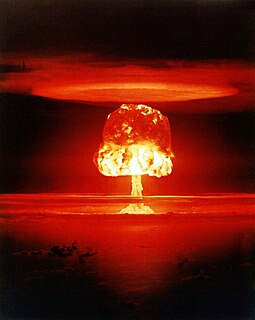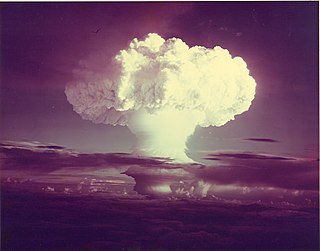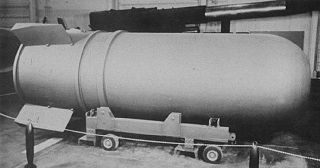
The Tsar Bomba, , also known by the alphanumerical designation AN602, was a hydrogen aerial bomb, and the most powerful nuclear weapon ever created and tested. Tsar Bomba was developed in the Soviet Union (USSR) by a group of nuclear physicists under the leadership of Igor Kurchatov, an academician of the Academy of Sciences of the Soviet Union.

Nuclear weapon designs are physical, chemical, and engineering arrangements that cause the physics package of a nuclear weapon to detonate. There are three existing basic design types:

Operation Castle was a United States series of high-yield (high-energy) nuclear tests by Joint Task Force 7 (JTF-7) at Bikini Atoll beginning in March 1954. It followed Operation Upshot–Knothole and preceded Operation Teapot.

Operation Upshot–Knothole was a series of eleven nuclear test shots conducted in 1953 at the Nevada Test Site. It followed Operation Ivy and preceded Operation Castle.

Castle Bravo was the first in a series of high-yield thermonuclear weapon design tests conducted by the United States at Bikini Atoll, Marshall Islands, as part of Operation Castle. Detonated on March 1, 1954, the device was the most powerful nuclear device detonated by the United States and its first lithium deuteride fueled thermonuclear weapon. Castle Bravo's yield was 15 megatons of TNT, 2.5 times the predicted 6.0 megatons, due to unforeseen additional reactions involving lithium-7, which led to the unexpected radioactive contamination of areas to the east of Bikini Atoll. At the time, it was the most powerful artificial explosion in history.

Ivy Mike was the codename given to the first full-scale test of a thermonuclear device, in which part of the explosive yield comes from nuclear fusion. Ivy Mike was detonated on November 1, 1952, by the United States on the island of Elugelab in Enewetak Atoll, in the now independent island nation of the Marshall Islands, as part of Operation Ivy. It was the first full test of the Teller–Ulam design, a staged fusion device.

Elugelab, or Elugelap, was an island, part of the Enewetak Atoll in the Marshall Islands. It was destroyed by the world's first true hydrogen bomb test on 1 November 1952, a test which was codenamed shot "Mike" of Operation Ivy. Prior to being destroyed, the island was described as "just another small naked island of the atoll".

The B-41 was a thermonuclear weapon deployed by the United States Strategic Air Command in the early 1960s. It was the most powerful nuclear bomb ever developed by the United States, with a maximum yield of 25 megatons of TNT. The B-41 was the only three-stage thermonuclear weapon fielded by the U.S.

Castle Romeo was the code name given to one of the tests in the Operation Castle series of U.S. nuclear tests. It was the first test of the TX-17 thermonuclear weapon, the first deployed thermonuclear bomb.

A thermonuclear weapon, fusion weapon or hydrogen bomb is a second-generation nuclear weapon design. Its greater sophistication affords it vastly greater destructive power than first-generation atomic bombs, a more compact size, a lower mass, or a combination of these benefits. Characteristics of nuclear fusion reactions make possible the use of non-fissile depleted uranium as the weapon's main fuel, thus allowing more efficient use of scarce fissile material such as uranium-235 or plutonium-239.

The Mark 15 nuclear bomb, or Mk-15, was a 1950s American thermonuclear bomb, the first relatively lightweight thermonuclear bomb created by the United States.

Canopus was the codename of the first French two-stage thermonuclear test. It was conducted by the Pacific Carrier Battle Group on 24 August 1968, at the Pacific Experiments Centre near Fangataufa atoll, French Polynesia. The test made France the fifth country to test a thermonuclear device after the United States, the Soviet Union, the United Kingdom and China.

Operation Redwing was a United States series of 17 nuclear test detonations from May to July 1956. They were conducted at Bikini and Enewetak atolls by Joint Task Force 7 (JTF7). The entire operation followed Project 56 and preceded Project 57. The primary intention was to test new, second-generation thermonuclear weapons. Also tested were fission devices intended to be used as primaries for thermonuclear weapons, and small tactical weapons for air defense. Redwing demonstrated the first United States airdrop of a deliverable hydrogen bomb during test Cherokee. Because the yields for many tests at Operation Castle in 1954 were dramatically higher than predictions, Redwing was conducted using an "energy budget": There were limits to the total amount of energy released, and the amount of fission yield was also strictly controlled. Fission, primarily "fast" fission of the natural uranium tamper surrounding the fusion capsule, greatly increases the yield of thermonuclear devices, and constitutes the great majority of the fallout, as nuclear fusion is a relatively clean reaction.

The Mark 21 nuclear bomb was a United States thermonuclear gravity bomb first produced in 1955. It was based on the TX 21 "Shrimp" prototype that had been detonated during the Castle Bravo test in March 1954. While most of the Operation Castle tests were intended to evaluate weapons intended for immediate stockpile, or which were already available for use as part of the Emergency Capability Program, Castle Bravo was intended to test a design which would drastically reduce the size and costs of the first generation of air-droppable atomic weapons.
The XW-35 was designed from the outset as a thermonuclear warhead for the first generation of ICBMs. Development was driven by the development of the Atlas missile, and when the accuracy of the Atlas was shown to be inferior to predictions the XW-35 design had to be altered to give a higher yield. By March 1958, the development of the XW-35-X1 was lagging. The XW-35-X1 was probably the device tested in the Koa shot of the Operation Hardtack I series. Predicted yield was 1.75 megatons; the actual yield was 1.37 megatons with the shortfall due to poor burning of the secondary. By this time the Air Force had designated the XW-49, a simple modification of the TX-28 already successfully tested during the Redwing series. By August 1958 the first dedicated missile warhead design, the W-35, had been cancelled in favor of the W-49.
The Koon shot of Operation Castle was a test of a thermonuclear device designed at the University of California Radiation Laboratory (UCRL), now Lawrence Livermore National Laboratory (LLNL).
The Robin was the common design nuclear fission bomb core for several Cold War designs for American nuclear and thermonuclear weapons, according to researcher Chuck Hansen.

A fizzle occurs when the detonation of a device for creating a nuclear explosion grossly fails to meet its expected yield. The cause(s) for the failure can be linked to improper design, poor construction, or lack of expertise. All countries that have had a nuclear weapons testing program have experienced some fizzles. A fizzle can spread radioactive material throughout the surrounding area, involve a partial fission reaction of the fissile material, or both. For practical purposes, a fizzle can still have considerable explosive yield when compared to conventional weapons.
Swan was a United States test nuclear explosive, which was developed into the XW-45 warhead.

The British hydrogen bomb programme was the ultimately successful British effort to develop hydrogen bombs between 1952 and 1958. During the early part of the Second World War, Britain had a nuclear weapons project, codenamed Tube Alloys. At the Quebec Conference in August 1943, British prime minister Winston Churchill and United States president Franklin Roosevelt signed the Quebec Agreement, merging Tube Alloys into the American Manhattan Project, in which many of Britain's top scientists participated. The British government trusted that America would share nuclear technology, which it considered to be a joint discovery, but the United States Atomic Energy Act of 1946 ended technical cooperation. Fearing a resurgence of American isolationism, and the loss of Britain's great power status, the British government resumed its own development effort, which was codenamed "High Explosive Research".















